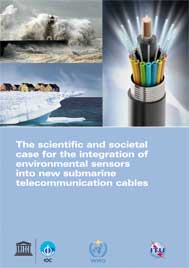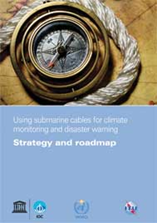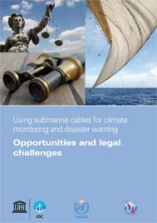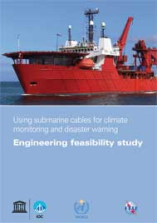SMART Cables for Observing the Global Ocean: Science and Implementation, Bruce M. Howe, Brian K. Arbic, Jérome Aucan, Christopher R. Barnes, Nigel Bayliff, Nathan Becker, Rhett Butler, Laurie Doyle, Shane Elipot, Gregory C. Johnson, Felix Landerer, Stephen Lentz, Douglas S. Luther, Malte Müller, John Mariano, Kate Panayotou, Charlotte Rowe, Hiroshi Ota, Y. Tony Song, Maik Thomas, Preston N. Thomas, Philip Thompson, Frederik Tilmann, Tobias Weber and Stuart Weinstein on behalf of the Joint Task Force for SMART Cables
N. Ranasinghe, C. Rowe, E. Syracuse, C. Larmat, M. Begnaud;
Enhanced Global Seismic Resolution Using Transoceanic SMART Cables. Seismological Research Letters ; 89 (1): 77–85. doi:
https://doi.org/10.1785/0220170068
This study researched four categories (International Development Agencies, Foundations, Governmental Agencies and Private Companies) of potential funding source for the Green Cables Initiative. For each category, potential funders were identified and were rated as to the likelihood of funding. This report is available
here.
Howe, B. M., and Workshop Participants (2015), From space to the deep seafloor: Using SMART submarine cable systems in the ocean observing system, Report of NASA Workshops, 9–10 October 2014, Pasadena, CA, and 26–28 May 2015, Honolulu, HI. SOEST Contribution 9549
The report and related material are available
here.
The scientific and societal case for the integration of environmental sensors into new  submarine telecommunication cables
submarine telecommunication cables
Our ocean and climate are experiencing global changes that will affect us and our descendants. Without access to the seafloor for fundamental oceanographic measurements, scientists cannot quantify and respond to the dilemma facing humanity. As we begin to make submarine telecommunication cables environmentally aware “green cables”, we look to a future where cables serve a dual purpose, both as communications infrastructure and a scientific backbone for monitoring tsunamis, earthquakes and the world’s seafloor temperatures and circulation.
This report (2014) was developed by the JTF Science and Society Committee under the leadership of Rhett Butler, University of Hawaii.
Download
here.
 Using Submarine Cables for Climate Monitoring and Disaster Warning: Strategy and Roadmap
Using Submarine Cables for Climate Monitoring and Disaster Warning: Strategy and Roadmap
This report presents a strategy and roadmap to move forward this vision of incorporating sensors into submarine cables. Nowadays, submarine telecommunication cables that traverse oceans transmit the global Internet, but are deaf, dumb and blind to their ocean environment around them. A future is envisioned when telecommunication companies integrate ocean-observing sensors within their submarine cable systems. This new sensory data would crucially advance our knowledge in monitoring global climate change and tsunamis in the deep ocean.
This report (2012) was written by Rhett Butler, University of Hawaii.
 Using Submarine Cables for Climate Monitoring and Disaster Warning: Opportunities and Legal Challenges
Using Submarine Cables for Climate Monitoring and Disaster Warning: Opportunities and Legal Challenges
Recognizing the newness of such uses of undersea telecommunications cables and the complexity of national and international legal-regulatory regimes, this report examines opportunities and legal challenges arising from dual-purpose telecom-marine data cables for ocean and climate monitoring and disaster warning.
This report (2012) was written by Kent Bressie, Wiltshire & Grannis LLP.
 Using Submarine Cables for Climate Monitoring and Disaster Warning: Engineering Feasibility Study
Using Submarine Cables for Climate Monitoring and Disaster Warning: Engineering Feasibility Study
This report investigates technical feasibility of modifying repeaters to support science instruments for incorporation into commercial telecom cables systems. Allowing and improving long term measurement and data collection, a “Green Repeater" equipped with science instruments will indeed contribute to the effort of better understanding the oceans and the changing climate.
This report (2012) was written by Peter Phibbs and Stephen Lentz, Mallin Consultants Ltd.